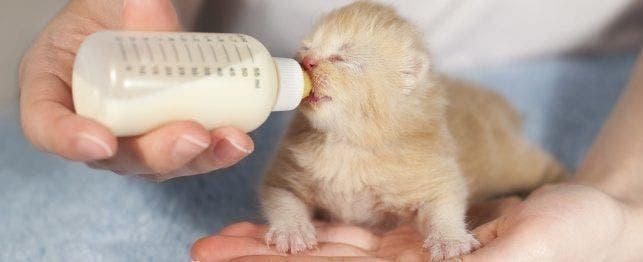
How Much Food Or Formula Should You Give a One-Day-Old Kitten?
Hi Dr. Debra,
We just found an orphaned 1-day-old kitten. It’s a sad story; the feral mom had problems giving birth and kittens came out but their “cords” were in a knot. The vet said that one of the kittens was still inside and stillborn, so he operated on and spayed the mom. But then 24 hours later, the vet tech was throwing away the garbage and heard the kitten crying in the trashcan…it was still alive and had worked its way out of the sack. I am pretty sure it won’t make it.
We tried calling a couple of vet clinics for advice and no one would talk to us. I’ve tube fed a lot of kittens and just wanted to know how much to feed. No one was comfortable telling us. Can you help? How much do you feed a one-day-old kitten?
Christine – NYC, NY
Hi Christine,
It is wonderful of you to help this kitten, and I’ll do my best to help you. This kitten is probably weak, dehydrated, and cold. The ideal would be to take it to a vet for medical care as soon as possible. If you can’t do that (and really, it’s the absolute best thing), I guess you just need to do the best you can. I’ll give you the best advice I can to help you care for this kitten without being able to see it myself.
In answer to your question on how much you feed a one-day-old kitten, the recommended daily feeding amount is based upon weight and age. Most milk replacement products contain 1 kcal/ml. This amount of milk should be divided into at least 4 feedings per day, and at one day of age, I’d recommend 6 to 8 feedings.
Here are some general guidelines based on body weight and amounts:
- Week 1: 13 to 15 ml per 100 g body weight
- Week 2: 15 to 18 ml per 100 g body weight
- Week 3: 20 ml per 100 g body weight
- Week 4: 20 ml per 100 g body weight and also eating mostly solid food
By the way, 100 grams is 3.5 oz., if it makes the calculations any easier.
If the kitten weighs 2 ounces (57 grams), you’d be giving a total of almost 8 mL of fluid per day. Divide this into 6 feedings, and each would be about 1.3 ml. I’d start slow with 1 ml if the kitten’s body temperature is over 99 degrees; you can always go up in quantity and down in frequency. For example, on day one you might give approximately 1 ml every 4 hours. If a few days down the road things are going OK, you could try to cut back to 4 times a day. If, on the other hand, the kitten weighed the same and therefore still required about 8 mL of formula, you’d be giving 2 ml every 6 hours.
It is important that the kitten be warm. If you feed a kitten with a low body temperature (hypothermia), they can’t digest the milk and you can actually do more harm than good. If possible, take your kitten’s temperature every few hours. Use a digital thermometer; I get an inexpensive one with a flexible tip from the local pharmacy, label it as the cat’s, and place it in the first aid box.
Providing heat support is so important because a kitten this age can’t regulate its own body temperature. If you have a spare shoebox, line the box with a thick towel and provide heat support such as a pet-safe heating pad or hot water bottle under half of the box so the kitten can stay on it or crawl off if they need to cool down.
Here are some really good resources for you that will help, too:
Caring for an Orphaned Kitten – This article has some great tips on feeding and care.
Caring for a Sick Kitten – Even though your kitten may not be sick, it never hurts to have these great care guidelines on what they need.
Caring for Newborn Kittens – Check out these great tips for general kitten care.
Best of luck to you!
Dr. Debra